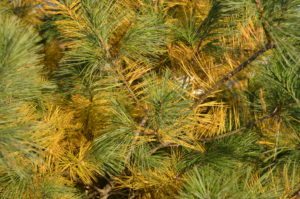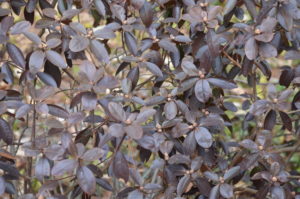Winter foliage burn on evergreens is often most prevalent on boxwoods (Buxus), hollies (Ilex), rhododendron, and many kinds of conifers. Symptoms often develop when temperatures warm up in late winter and early spring. This type of winter damage is often misdiagnosed as an infectious disease or damage from excessively cold temperatures.
Evergreens transpire (lose water from needles or leaves) over the course of a day. For a large pine or fir tree, that may be hundreds of gallons of water daily on a dry winter day. Conditions may worsen if the soil is dry or frozen. Roots in frozen soil are incapable of replacing moisture loss and leaves desiccate, die, and turn brown.
Major Causes: Leaf burn or water loss is frequently greater on plants located on the south and west sides of homes where the late afternoon air is warmest because of sunlight exposure and heat. De-icing salt spray from nearby streets (roads) or sidewalks may also burn evergreen foliage. High winds may dry out needles.
To Prevent Winter Burn (in order of priority):
- Select trees and shrubs that are hardy to your region.
- Plant broadleaved evergreens such as rhododendrons, needle conifers, and hollies (Ilex) in areas sheltered from high winds.
- Around Thanksgiving (mid-November) holidays, irrigate plants deeply before the ground freezes if little precipitation is expected.
- On windy sites plant a natural tree/shrub windbreak around your home, composed of fast-growing evergreen and deciduous trees.
- Construct physical barriers from landscape tarp or slatted snow fencing to protect problem plants with burlap or landscape fabric.
- Use of chemical anti-transpirants (available at most garden centers) should be your last resort. Follow package recommendation closely, but do not overuse these products.
- Maintain a 3-4 inch layer of organic mulch around evergreens to retain soil moisture.
Assessing winter injury and recovery rate of foliar burned evergreens is a waiting game. Hold off until late spring before pruning away dead and damaged branches. Burnt needles will not recover. Dead appearing branches may still possess surviving buds that will green up and fill in some bare patches. Prune off all dead branches that have not greened up.



 Posted in
Posted in 
